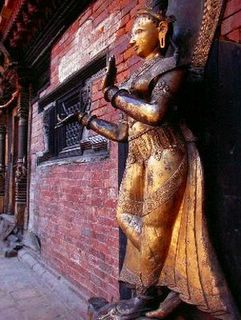 |
 |
Jonathan Gregson, in his book "Massacre at the Palace", explains:
"He had apparently attempted to blow his own brains out. The single shot to his head left him virtually brain-dead, but his vital functions did not cease for another two days. As a result, during those two days, as dictated by the rules of royal succession, the man who had committed parricide, matricide, and fratricide, and had bungled his own suicide was briefly declared King Dipendra of Nepal. Nobody, not even the most morbid of Jacobean playwrights or Greek tragedians, could have invented a plot with so much self-inflicted damage, nor such a bizarre twist at the end."
Dipendra did not survive and the Nepalese royal line, which had ruled for more than 200 years, was decimated. Having survived so many external threats and with a civil war raging in the background, it is the ultimate irony that the royal family eventually succumbed to an attack from within.
To this day, Dipendra's motive remains somewhat elusive. Gregson depicts him as a young man who had a strained relationship with his parents. The younger brother Nirajan, with his more amiable nature appeared to be Queen Aiswarya's favorite, and even the King seems cold and distant with his first-born. Dipendra was was also frustrated by his very mundane duties as Crown Prince. Ever since Nepal made the transition to democracy in 1990, the Royal family, although they retained their titles, no longer ruled Nepal. His role in this consitutional monarchy was boring and uninspiring to him.
It is clear that he wished to marry against his parents' wishes and this is believed to have caused him huge distress. In 1997, he fell for an aristocratic young woman, Devyani Rana, and the couple began a clandestine affair. He wished to marry her, but his mother, Queen Aiswarya, worked tirelessly to prevent it from happening.
Dipendra also had his own personal demons---he was putting on weight at an alarming rate, he was drinking and smoking far too much. He had high cholesterol and high blood pressure and to make matters worse, he was also losing his hair. He felt like everything was against him leading him to suffer from depression and exhibiting numerous mood swings. On his 29th birthday, he announced that he would marry Devyani and shoot anyone, including his parents if they stood in his way. When his heavily pregnant sister, Shruthi, 'shoo'ed' him for talking like that he struck he struck her so hard she fell to the ground. It was a grim prelude, but nobody saw the warning signal.
Dipendra was then presented with the ultimate deterrent: that he would be stripped of his royal titles and allowance if he persisted in defying his parents. According to the book, Dipendra was prepared to give it all up for love, but Devyani "went white with rage" when she heard that she wouldn't get to be Queen of Nepal. Ofcourse, Devyani's family denies that this was the sentiment.
Theories abound as to what tipped the Prince over the edge on that hot summer evening, but no one really knows. The Crown Prince spoke to Devyani minutes before he carried out the murders and telephone records show that she later phoned his security personnel and begged them to find him urgently. He had consumed whiskey and hashish mixed with "a strange black substance".
Gregson chronicles the shooting and its aftermath with ease, but little insight is offered. Much of it is drawn from the official report and although he interviewed several palace officials, they did not yield much information. The book fails to shed much light on what went on behind the closed doors of the Royal Palace in Katmandu, but in the pages before the shooting he presents a wonderful overview of Nepal's history and a character assasination of quite a few members of Nepal's royal family.
This is a skeleton that looks likely to remain in the royal closet.
Nepalis do not accept the official version of the bloodbath, and soon after the tragedy fingers were pointed at Gyanendra, Birendra's younger brother.
Related links:Opinion piece in The Wall Street Journal discusses the mystery surrounding the massacre of Nepal’s royal family Regicide Reappears |
The suspicion still lingers, and has been one reason for King Gyanendra's dwindling support among his subjects. They feel —all the more — he is guilty because there have been convictions till date.
